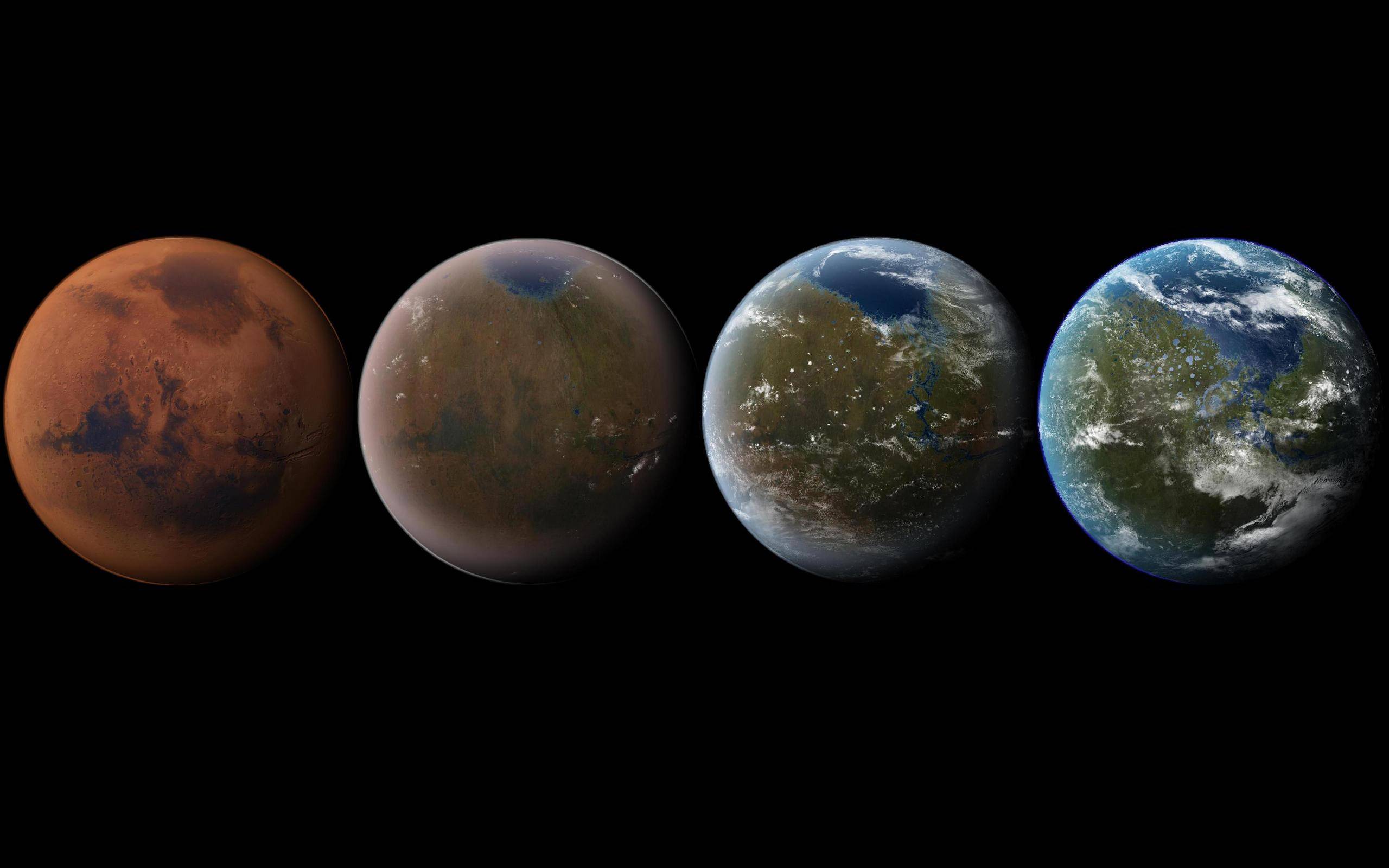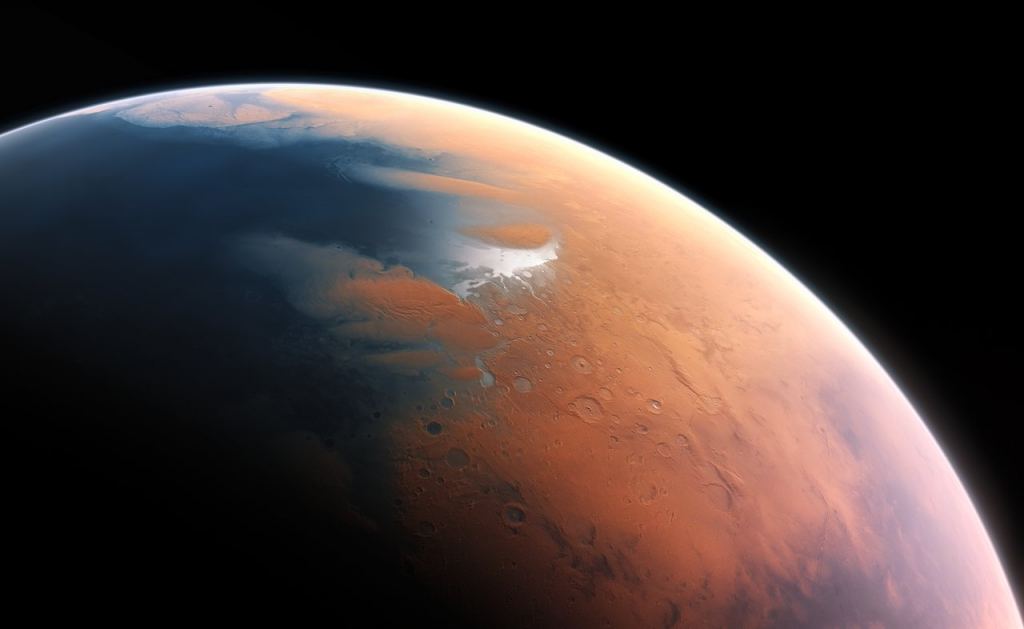The idea of terraforming Mars, making its atmosphere and environment more Earth-like for human settlement, goes back decades. During that time, many proposed methods have been considered and put aside as "too expensive" or requiring technology well in advance of what we have today. Nevertheless, the idea has persisted and is often considered a part of long-term plans for establishing a human presence on Mars. Given the many plans to establish human outposts on the Moon and then use that infrastructure to send missions to Mars, opportunities for terraforming may be closer than we think.
Unfortunately, any plans for terraforming Mars suffer from unresolved hurdles, not the least of which are the expense, distance, and the need for technologies that don't currently exist. Triggering a greenhouse effect and warming the surface of Mars would take massive amounts of greenhouse gases, which would be very difficult and expensive to transport. However, a team of engineers and geophysicists led by the University of Chicago proposed a new method for terraforming Mars with nanoparticles. This method would take advantage of resources already present on the Martian surface and, according to their feasibility study, would be enough to start the terraforming process.
The team was led by Samaneh Ansari, a postdoctoral student at the Department of Electrical and Computer Engineering (ECE) at Northwestern University. She was joined by Edwin Kite, an Assistant Professor of Geophysical Sciences at the University of Chicago; Ramses Ramirez, an Assistant Professor with the Department of Physics at the University of Central Florida; Liam J. Steele, a former postdoctoral researcher at UChicago, now with the European Center for Medium-Range Weather Forecasts (ECMWF), and Hooman Mohseni, a Professor of ECE at Northwestern (and Ansari's postdoc advisor).
As addressed in previous articles, the process of terraforming Mars comes down to a few steps, all of which are complementary. This is to say, progress made in one area will invariably have a positive effect on another. Those steps include:
- *Warming the planet*
- *Thickening the atmosphere*
- *Melting the water ice*
By warming the planet, the polar ice caps and permafrost would melt, releasing liquid water onto the surface and as vapor into the atmosphere. The abundant amounts of dry ice in both ice caps (especially in the southern hemisphere) would also be released, thickening the atmosphere and warming it further. As Robert Zubrin argued in *The Case for Mars*, this would lead to an atmospheric pressure (atm) of about 300 millibars (30% of Earth's atm at sea level), which would allow for people to stand outside on the surface without a pressure suit (though they would still need warm clothing and bottled oxygen).
In the past, proposals for terraforming Mars have recommended that the first step be achieved by triggering a greenhouse effect, most notably by introducing additional greenhouse gases. Examples include additional carbon dioxide, methane, ammonia, and chlorofluorocarbons, which would either need to be mined on Mars or imported from Earth (or Venus, Titan, and the outer Solar System). Unfortunately, these options would require a fleet of spacecraft making two-way trips to Mars, Venus, or the outer Solar System and/or heavy mining operations on Mars.
In contrast, the proposal put forth by Ansari and her colleagues involves using engineered dust particles fashioned from local minerals*. Thanks to missions like Curiosity and Perseverance, which have obtained multiple samples of rock and soil for analysis, we know that dust grains on Mars are rich in iron and aluminum. When fashioned into conductive nanorods measuring about 9 micrometers long - the width of a very thin human hair - and arranged in different configurations, these particles could released into the atmosphere, where they would absorb and scatter sunlight.
To determine the extent to which these particles would affect Mars' atmosphere, the team conducted simulations using the Quest high-performance computing cluster at Northwestern University and the Midway 2 computing cluster at the University of Chicago Research Computing Center (RCC). Based on a 10-year particle lifetime, two climate models were simulated where 30 liters (7.9 gallons) of nanoparticles per second were consistently launched into the atmosphere. Their results indicate that this process would warm Mars by more than 30 °C (86 °F), enough to trigger the melting of the polar ice caps.
Based on their simulations, the team found that their method is over 5,000 times more efficient than previous proposals to trigger a greenhouse effect on Mars. In addition, the average temperature increase would make the Martian environment suitable for microbial life, which is vital for plans to ecologically transform Mars. Through the introduction of photosynthetic bacteria (like cyanobacteria), atmospheric carbon dioxide could be slowly converted into oxygen gas. This is precisely how oxygen became an integral part of Earth's atmosphere, starting 3.5 billion years ago.
As Kite indicated in a UChicago News story, this method would still take decades but would be logistically easier and much cheaper than current plans to terraform Mars:
"This suggests that the barrier to warming Mars to allow liquid water is not as high as previously thought. You'd still need millions of tons to warm the planet, but that's five thousand times less than you would need with previous proposals to globally warm Mars. This significantly increases the feasibility of the project. This suggests that the barrier to warming Mars to allow liquid water is not as high as previously thought."
Naturally, a lot of additional research needs to be done before such a method can be field-tested on Mars. Not the least of which are the unresolved questions of how the particles will be affected by atmospheric changes on Mars. Currently, Mars experiences cloud formation and precipitation in the form of dry ice condensing in the atmosphere and falling back toward the surface as CO2 snow. Once the polar ice caps are melted, Mars could experience more cloud cover and precipitation involving water, which could condense around the particles, causing them to fall back to the surface in raindrops.
This and other potential climate feedback mechanisms could lead to a myriad of problems. But one of the best aspects of this proposed method is its reversibility. Simply stop producing and releasing the particles into the atmosphere, and the warming effect will end with time. What's more, the focus of the study only extends to warming the atmosphere to the extent that microbial life could live there and food crops eventually planted. Nevertheless, this study offers terraforming enthusiasts a viable and more affordable option for getting the ball rolling on the whole " Greening of Mars " process. Said Kite:
"Climate feedbacks are really difficult to model accurately. To implement something like this, we would need more data from both Mars and Earth, and we'd need to proceed slowly and reversibly to ensure the effects work as intended. This research opens new avenues for exploration and potentially brings us one step closer to the long-held dream of establishing a sustainable human presence on Mars."
As the saying goes, "A journey of a thousand miles begins with a single step." In this case, the first step is perhaps the most daunting, comparable only to the challenges of ensuring that changes in Mars' climate are maintained in the long run. By offering future generations a viable and (comparatively) cost-effective option, we might achieve the dream of making Mars hospitable to terrestrial life!
*This process is known as In-Situ Resource Utilization (ISRU), a major component of NASA's Moon to Mars mission architecture and other plans to create a permanent human presence on the Moon and Mars in the coming decades.
*Further Reading: University of Chicago News, Nature Advances*
 Universe Today
Universe Today


